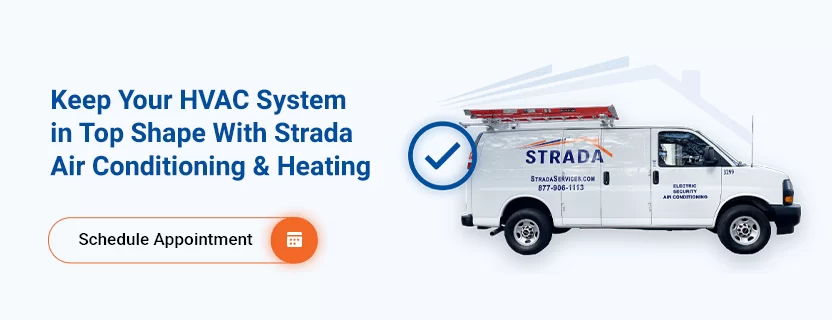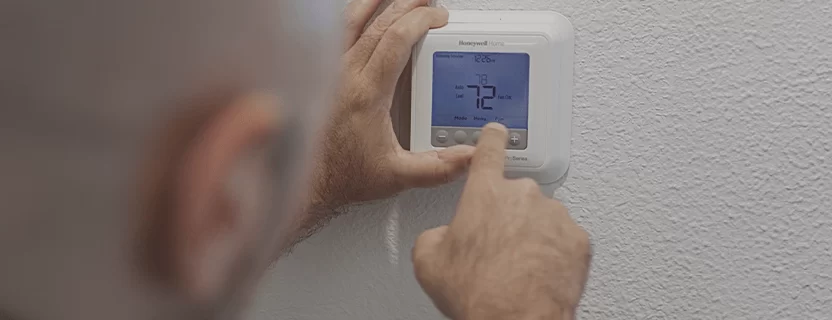
Southeastern states are known for high temperatures and a humid, subtropical climate. On a sweltering day, having your heating, ventilation and air conditioning (HVAC) system break down is the last thing you want to happen. Performing preventive maintenance is the key to keeping your family comfortable all year round.
Like a car, your AC system has many moving parts that require extra attention now and then. The unit may decline over time, causing it to use more energy to function properly. Regular service reduces the risk of breakdowns and contributes to a longer life span. Fortunately, you can DIY some of this upkeep with these home air conditioner maintenance tips.
Creating a proactive checklist for regular checkups can help your AC function efficiently and effectively for years to come. Below are our top preventive maintenance tips for air conditioners in your home.
Your HVAC system contains air filters that capture contaminants like dust and pet hair. The filters can clog over time, interfering with your AC’s operation and making it work harder than necessary. Additionally, dirty air filters reduce your indoor air quality.
Cleaning or replacing your air filters regularly is one of the top tips for AC maintenance to ensure maximum efficiency. How often you should change your AC air filter depends on where you live and how often you run your system. As a general rule, change your disposable air filters every one to three months. During high-use seasons like summer, it’s recommended to change it once a month. If you have washable air filters, simply clean them with running water, allow them to dry and reinsert them.
You can determine your air filter’s performance by checking the Minimum Efficiency Reporting Values (MERV). This rating determines how well your filter traps particles. The higher the rating, the better the filtration — and the more often you should change it.
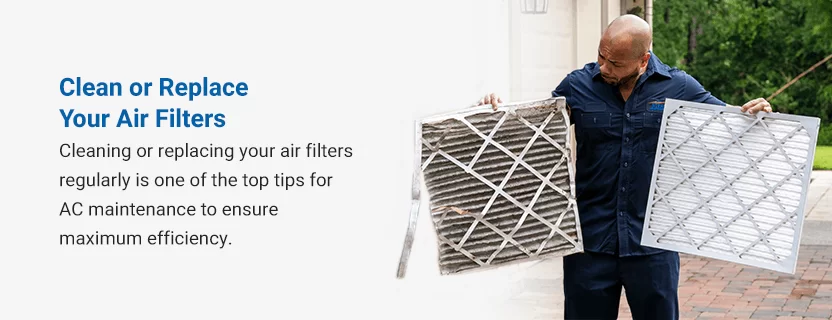
One of our key summer AC maintenance tips is to check and stop leaks in their tracks. Your ductwork can be difficult to seal properly, which makes it even more challenging to detect leaks that reduce your airflow. You notice signs of air leaks if your utility bills are higher than usual or you feel air emerging from the exposed joints. If you suspect a leak but aren’t sure, light a stick of incense and hold it close to the joints to see if it changes direction.
If the smoke blows away or toward a source, you probably have a leak. If you happen to have a fog machine lying around, place it near your intake fan so you can clearly see if and where leaks appear.
Are you someone who sets the temperature higher before you leave the house for the day? This strategy can reduce energy costs and eliminate the unnecessary need for your system to blast all day to cool your house down. Sometimes, it’s easy to forget to adjust the thermostat on a busy morning while you’re running out the door.
Installing a smart, programmable thermostat is an essential air conditioner maintenance tip because it lets you set your ideal temperatures for various times throughout the day. This means your central AC will automatically adjust to the right temperature without you having to constantly change it, saving you money and reducing the strain on your AC during high-use months.
Older HVAC systems may have service ports for applying lubricant. Be sure to refer to the instruction manual to determine the recommended lubricant for your motors and bearings. Inject the lubricant into the port to keep your fan and compressor running smoothly. Newer AC systems tend to be self-lubricating.
Cleaning your evaporator coil is among the top end-of-summer AC maintenance tips. The evaporator coil door is located on the inside blower/furnace unit. The coil door may have some foil duct tape or screws that you need to remove first.
Then, dust the evaporator coil using a soft brush. Spray it with a no-rinse coil cleaner, which you can find at most home improvement stores. The coil cleaner will foam up and run off into the drain pan. Check out the next tip to learn how to unclog the drain tube and clean the pan.
Once you cleaned off the evaporator coil, you’ll need to check the drain pan and tube. Your AC unit drains excess moisture from the condenser. If you notice puddles of water around your furnace, it’s likely due to a clogged condensate drain tube. If you want to avoid mold, slime and algae growth in your drain line, it’s important to follow these maintenance tips for AC.
Check the condensate tray or pan in your indoor unit to see whether the water is dripping out as it should. If not, this means moisture is likely getting inside your home’s AC system, which could lead to mold and mildew growth. A plugged drain could also cause damage by flooding the floor or stopping your AC from cooling to avoid flooding.
Find the exit point of the drain line where it leaves the evaporator coil enclosure. The condensate drain tube is usually a white, gray or black PVC pipe about an inch thick and often drains into a basement floor drain or utility sink. Use a vacuum to suck out any obstructions or biological matter in the drain. You can also use a long, thin brush to clean out debris.
Flush the drain with a mixture of hot water, soap and a small amount of bleach. Wait for about 30 minutes, then flush water through the drain and make sure it flows smoothly. You’ll likely need to empty the drain pain once you’ve cleared the blockage. Replace the evaporator coil door and reseal the duct tape if needed.
Your central AC system’s compressor and condenser are often located outside your home near the foundation. This unit needs plenty of clear space to have proper airflow. One of our top spring AC maintenance tips is to check your outside unit regularly to remove any plant life. Leaves, branches, overgrown shrubs, weeds, grass clippings or other debris can easily obstruct airflow. This can make your unit work harder than it has to and can reduce its capacity.
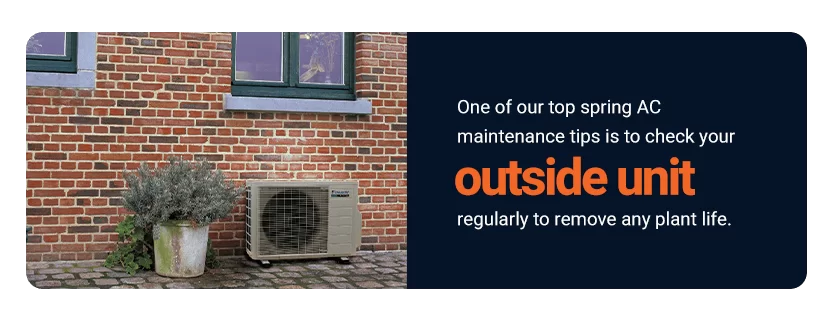
Shut off power to the unit and use a hose or damp cloth to gently clear away debris, starting from the top and working your way down. Using something too strong, like a power washer, can easily damage the fins on the coil or the internal electrical components.
If you have lots of plant life or a garden near the unit, use the general rule of keeping roughly 24 inches of clear space on all of its sides.
Your AC compressor has aluminum cooling fins that help the unit run efficiently. These fins are extremely delicate and can get bent easily, blocking airflow through the coil. They can also collect debris. To access the cooling fins, you may have to unscrew a metal box. Take care to avoid bumping the fins.
Once they’re cleaned, you can straighten them out yourself using a fin comb or a similar gentle, thin brush. If the fins are only slightly bent, you can usually bend them back into their original condition with gentle pressure. If the cooling fins are severely bent or crushed, carefully insert a butter knife no more than half an inch in to twist them back into shape.
It’s important to regularly check the condition of your condenser unit’s fan blades. If they’re in poor shape, your AC won’t be able to cool your home very well. Turn off the power to the system and inspect the fan located at the top of the outside condenser unit. It might be time to replace them if you notice visible chips or cracks.
You can purchase condenser unit fan blades from most air conditioner supply websites. You can also contact a professional HVAC technician to install them for you and provide other DIY central air conditioner maintenance tips.
One of the best AC unit maintenance tips for checking for leaks is inspecting the refrigerant level. It’s important that it doesn’t fall below the minimum required level. If it does, your AC may not cool properly or fail to start entirely. Check your refrigerant level often, especially if you notice warm air circulating in your home.
Turn off your AC unit, remove the cover and locate the refrigerant level pressure gauge. If the refrigerant level is too low or high, you may need a new compressor. Low levels can indicate a serious issue. If the level is not visible at all, check for leaks using the following steps:
Inefficient cooling may be caused by issues with the internal connections on your AC system, which can wear down over time. To prevent these issues from worsening, it’s recommended to check your outdoor unit’s wiring and components annually. Turn off the power to the condenser unit and remove the access panel. Look for signs of damage from overheating, such as:
If you spot any of these issues, a local heating and air conditioning expert can help you resolve them.
Making sure your air conditioner is level is one of the less-obvious home maintenance tips for AC, but it’s important. A slightly uneven air conditioner may not appear to be an issue at first, but it will continue to sink and become more unlevel over time. As the pad where the condenser unit sits tilts more and more, it could potentially tip over and disconnect from the refrigerant line. This would cause a dangerous leak.
The condenser pump won’t work correctly if it’s not level. The tilt could cause lubricant to pool up and cause premature wear on components that need it. If you have a heat pump system, it’s OK if your unit or pad is slightly tilted away from your foundation. This angle makes it easier for defrost run-off to drain during colder months.
The insulation that lines your ductwork and copper piping helps maintain thermal efficiency throughout the entire HVAC system. The copper piping is responsible for transporting refrigerant between your indoor and outdoor AC units. If too much condensation forms on your outdoor lines, it could raise your energy costs and make your system work harder than necessary.
Another essential maintenance tip for your air conditioner is to check your insulation for damage or signs of rot. It will be black or white foam located around the pipework. If it appears damaged from weather, rodents or insects, replace it to keep the air cool. You can use batt insulation, rigid foam insulation or spray foam. If you notice any exposed pipes, it’s best to contact an HVAC professional.
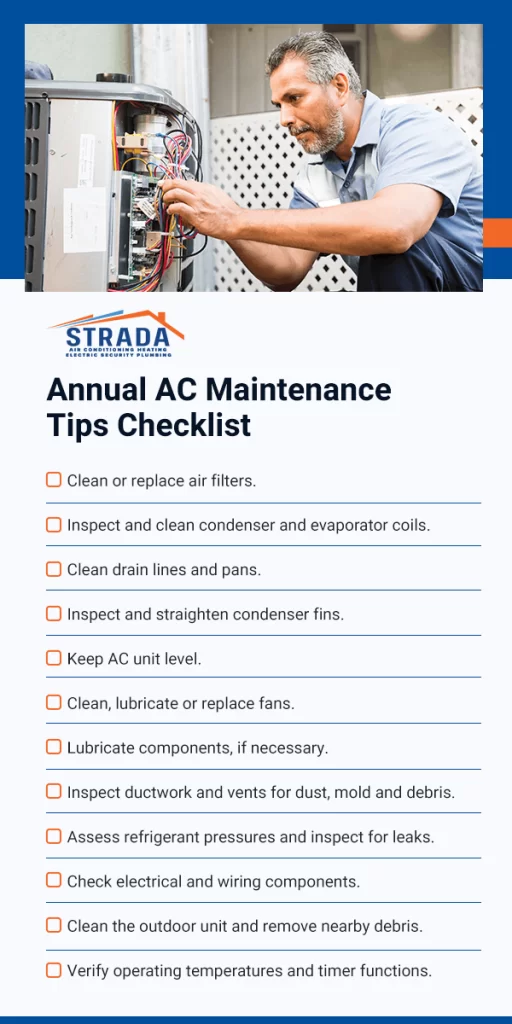
Doing home maintenance on your AC can help your unit run longer and more efficiently. If you’re comfortable with doing regular preventive maintenance yourself, keeping a checklist can help streamline the process and ensure you don’t miss an important step.
Refer to this handy checklist:
While these central AC unit maintenance tips are great for keeping your system in top shape, it’s understandable if you don’t have the time or ability to complete them all. If you don’t feel confident maneuvering your way through the complex components of your HVAC system, there’s no need to worry. Calling a professional is the best solution to ensure your air conditioner stays efficient as long as possible.
Even if you find yourself successfully working through these preventive maintenance tips for air conditioners, a professional technician can inspect for hidden issues you may not see. A highly trained HVAC technician will perform a thorough sweep of the unit and check its integrity and efficiency.
Having this done once or twice a year will prevent issues from worsening and keep your system performing at its best — especially during high-use months! You’ll have peace of mind knowing you’re not risking unintentional damage to your system or home by having it serviced by a professional technician.
We hope these tips for air conditioner maintenance have helped you understand how to extend its life span. Regular maintenance is critical for improved performance and airflow, but if your needs surpass a routine cleaning, don’t hesitate to rely on Strada Air Conditioning & Heating. We’re your trusted partner for all HVAC installations, repair and maintenance services. If your AC isn’t working as efficiently as it should, our expert technicians will identify and resolve the issue.
We understand how uncomfortable it can be when your AC gives out on a hot day. That’s why we’re committed to delivering exceptional service for maximum comfort. Whether you need assistance changing your air filters or intensive repairs, you can count on us to ensure your system is running at its best. Schedule an appointment or call us today to get started.
